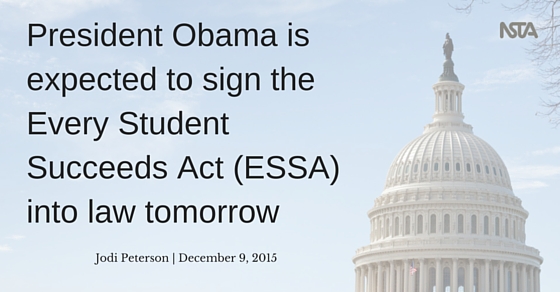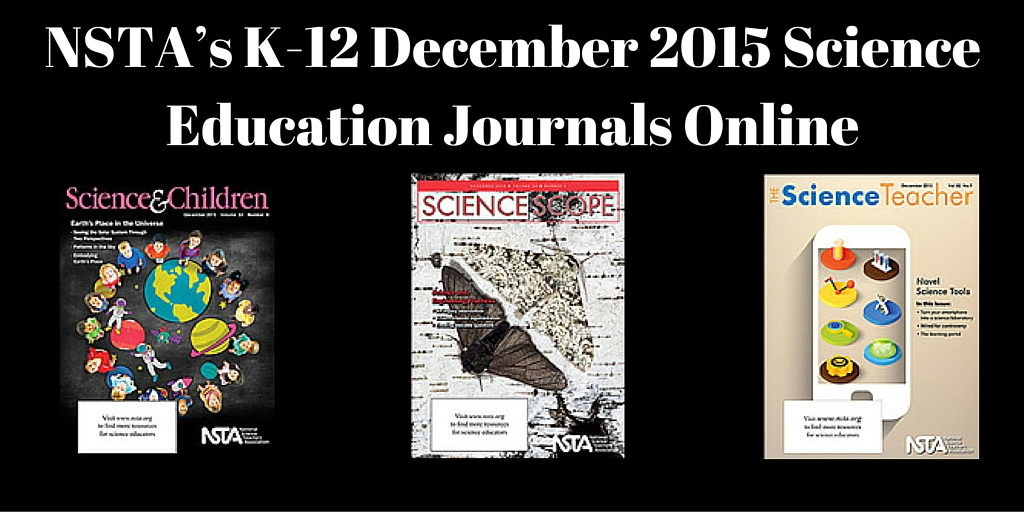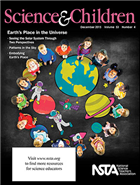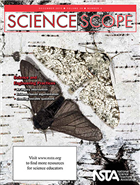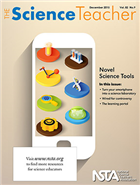Senate Passes ESSA, President Obama to Sign Bill into Law Tomorrow, Dec. 10
By Jodi Peterson
Posted on 2015-12-09
On Weds. Dec. 9, the Senate approved the bill to reauthorize No Child Left Behind by a vote of 85 to 12, and President Obama is expected to sign the Every Student Succeeds Act (ESSA) into law tomorrow, ending the seven year effort to replace the widely unpopular 2002 federal education statute with a new law that provides much more power back to the states and local districts.
The 12 Senators voting against the bill were Sens. Roy Blunt (MO), Mike Crapo (ID), Steve Daines (MT), Jeff Flake (AZ), Mike Lee (UT), Jerry Moran (KS) , Rand Paul (KY), James Risch (ID), Ben Sasse (NE), Tim Scott (SC), Richard Shelby (AL) and David Vitter (LA). The three presidential candidates, Sens. Cruz, Rubio and Sanders, did not vote.
Last week, the House passed the bill by a vote of 369 to 64 on Wednesday, December 2, to approve the Every Student Succeeds Act.
The ESSA consolidates a number of programs (including the Math and Science Partnership) into a block grant to the states. Although it maintains the federal rule on testing (once every year in grades 3-8 for ELA and math and three times in science), the new law provide more opportunities for districts and states to develop and provide STEM opportunities to students and professional learning to teachers.
For background information on the bill to reauthorize No Child Left Behind and the Every Student Succeeds Act (ESSA) please read this blog.
Jodi Peterson is Assistant Executive Director of Legislative Affairs for the National Science Teachers Association (NSTA) and Chair of the STEM Education Coalition. e-mail Peterson at jpeterson@nsta.org; follow her on Twitter at @stemedadvocate.
The mission of NSTA is to promote excellence and innovation in science teaching and learning for all.
Follow NSTA
NSTA’s K-12 December 2015 Science Education Journals Online
By Korei Martin
Posted on 2015-12-09
Want to give your students a sense of the Earth’s place in the universe? Wondering how you can strengthen your students’ grasp of science and engineering concepts? Curious about how today’s technology can assist you in teaching? The December K–12 journals from the National Science Teachers Association (NSTA) have the answers you need. Written by science teachers for science teachers, these peer-reviewed journals are targeted to your teaching level and are packed with lesson plans, expert advice, and ideas for using whatever time/space you have available. Browse the December issues; they are online (see below), in members’ mailboxes, and ready to inspire teachers!
As scientists continue to investigate other planets and solar systems, understanding the universe has become increasingly important. This issue of S&C offers ways to help you deepen your students’ interest in Earth’s place in the universe.
Featured articles (please note, only those marked “free” are available to nonmembers without a fee):
- Adapt or Discard?
- Free – Editor’s Note: Earth’s Place in the Universe—Understanding Develops Over Time
- Free – Embodying Earth’s Place in the Solar System
- Fossil Explorers
- Map That Find!
- Patterns in the Sky
- Seeing the Solar System Through Two Perspectives
- Table of Contents
Having students construct an evidence-supported explanation of why an insect’s coloring might affect its population size is just one way to assess their mastery of specific science practices. You’ll find other strategies for assessing and strengthening students’ grasp of science and engineering practices inside this issue of Science Scope.
Featured articles (please note, only those marked “free” are available to nonmembers without a fee):
- Argumentation and Explanation: Tools for Using Them Together While Keeping Them Separate
- Assessing Science Practices: Moving Your Class Along a Continuum
- Authentic Science Investigation in the Classroom: Tools for Creating Original, Testable Questions and Graphical Hypotheses
- Free – Editor’s Roundtable: The End of the Grand Parade
- Free – My Journey to Understand and Implement the NGSS
- Present, Critique, Reflect, and Refine
- The ICAN Intervention: Helping Science Learners Make Connections to Content During Inquiry
- Table of Contents
In the classic 1980s Back to the Future films, the imagined world of 2015 contained an array of fantastic new technologies, from flying cars and hovering skateboards to flat panel televisions and video chat systems. We don’t yet have flying cars or hoverboards, but if the films’ characters could have time-traveled to a real 2015 science classroom, they would have been amazed by the technologies actually available to today’s teachers, tools unimaginable 30 years—or even a decade—ago. This issue describes some of these new technologies: GIS mapping tools to plot bird diversity, digital probeware to study the greenhouse effect, online simulations to investigate DNA and energy, and even cell phones as digital sensors to explore Newton’s laws of motion.
Featured articles (please note, only those marked “free” are available to nonmembers without a fee):
- Clearing the Air
- Climbing the NGSS Mountain
- Free – Editor’s Corner: The Future Is Now
- The Learning Portal
- Turn Your Smartphone Into a Science Laboratory
- Where the Birds Live
- Free – Wired for Controversy
- Table of Contents
Get these journals in your mailbox as well as your inbox—become an NSTA member!
The mission of NSTA is to promote excellence and innovation in science teaching and learning for all.
Follow NSTA


